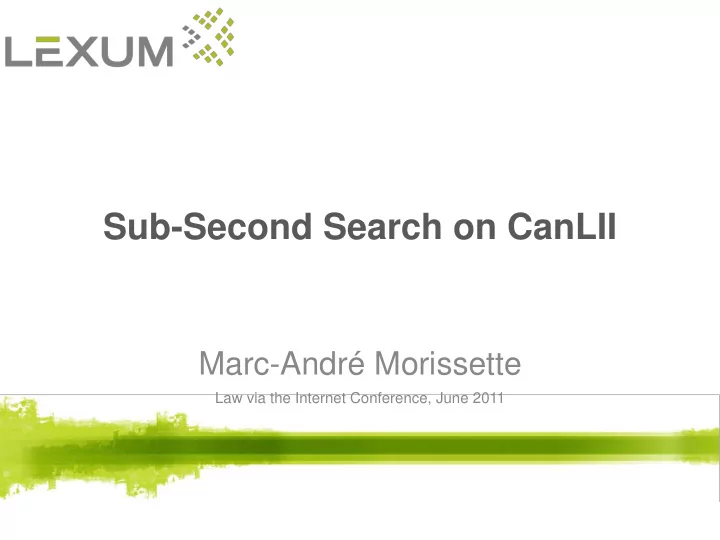

Sub-Second Search on CanLII Marc-André Morissette Law via the Internet Conference, June 2011
Overview Why are fast search engines important? An introduction to search engine theory CanLII’s search engine Algorithmic improvement: bigrams Server improvements Conclusion: what’s next?
Why are Fast Search Engines Important? Search is hard Search algorithms are still nowhere near “intelligent” People are bad at formulating queries A search experience should be Iterative: queries are refined based on the results of the previous iteration Fast: queries return results under a second CanLII was getting slower Content kept growing > 1M documents; 3.5 billion words; 13 million pages of unique text Limited processing power
Search Engine Theory Two phases, hence two programs Phase 1: an indexer reads every document to be searched and creates an inverted index Phase 2: a searcher performs keyword searches on the inverted index Inverted index A sorted dictionary of all words For every word, a list of all documents containing them For every word-document pair, a list of all the occurrences in the document of that word
Inverted Index: an Example Two documents Doc 1: The quick brown fox jumps Doc 2: The fox and the dog sleep The Inverted Index Word Doc. Freq Occurences And 1 (Doc=2;Freq=1;Pos=3) Brown 1 (Doc=1;Freq=1;Pos=3) Dog 1 (Doc=2;Freq=1;Pos=5) Fox 2 (Doc=1;Freq=1;Pos=4) (Doc=2;Freq=1;Pos=2) Jumps 1 (Doc=1;Freq=1;Pos=5) Quick 1 (Doc=1;Freq=1;Pos=2) Sleep 1 (Doc=2;Freq=1;Pos=6) The 2 (Doc=1;Freq=1;Pos=1) (Doc=2;Freq=2;Pos=1,4)
Phrase Query: an Example Query: “ the fox” Example Doc 1: The quick brown fox jumps Doc 2: The fox and the dog sleep Word Doc. Freq Occurences Fox 2 (Doc=1;Freq=1;Pos=4) (Doc=2;Freq=1;Pos=2) The 2 (Doc=1;Freq=1;Pos=1) (Doc=2;Freq=2;Pos=1,4) Performance # query terms * database size * length of documents
CanLII’s Search Engine Queries without operators: consider every possibility Word Prob VSM score Weighted score Workplace privacy dismissal 53% 0.45 0.239 “ Workplace privacy ” dismissal 35% 0.85 0.298 Workplace “ privacy dismissal ” 8% 0 0 “ Workplace privacy dismissal ” 4% 0 0 Total 100% Sum: 0.536 Probability is calculated by Machine Learning Algorithm Based on a training set of properly quoted queries from our log Performance Similar to phrase query
CanLII’s Old Search Engine: Theoretical Performance Performance is linear Example: Section 16 of the with amount of Criminal Code content Terms Calculations Size on Disk performance: disk dependant on size of Section 27 MB 431,147 Inverted Index data to 16 be read from disk 597,170 12 MB Criminal 86,560 3 MB CPU performance: Code dependant on the 229,905 6 MB quantity of Section-16 4,556,400 comparisons to be 16-Criminal 644,938 made Criminal-Code 610,891 Total 7,151,011 48 MB
CanLII’s Old Search Engine: Real World Performance Example: Section 16 of the Criminal Code Component Time required Basic overhead (constant) 120 ms Result display (constant) 350 ms Fetch occurrences from disk (variable) 3000 ms Compute score (variable) 1830 ms Total 5300 ms
Algorithmic Improvement: Bigrams Most difficult information to compute The position information for words that occur often: large sums of data To fetch To compute Solution: pre-compute a lot of the information Bigrams: insert in the inverted index a new dictionary entry for every word pair
Bigrams: an Example of an Inverted Index Example: The quick brown fox jumps Word Occurrences Brown (Doc=1;Freq=1;Pos=3) Brown-Fox (Doc=1;Freq=1;Pos=3) Fox (Doc=1;Freq=1;Pos=4) Fox-Jumps (Doc=1;Freq=1;Pos=4) Jumps (Doc=1;Freq=1;Pos=5) Quick (Doc=1;Freq=1;Pos=2) Quick-Brown (Doc=1;Freq=1;Pos=2) The (Doc=1;Freq=1;Pos=1) The-Quick (Doc=1;Freq=1;Pos=1)
Searching an Inverted Index with Bigrams: an Example Example query: “quick brown fox” Word Occurrences Brown-Fox (Doc=1;Freq=1;Pos=3) Quick-Brown (Doc=1;Freq=1;Pos=2) Significantly faster Because bigrams occur significantly less often than their component words
Bigrams: Theoretical Performance Improvement Example: Section 16 of the Criminal Code Word Without bigrams With bigrams Calculations Size on disk Calculations Size on disk Section 27 MB 431,147 431,147 1,7 MB 16 597,170 12 MB 597,170 2,4 MB Criminal 86,560 3 MB 86,560 0,3 MB Code 6 MB 229,905 229,905 0,9 MB Section-16 4,556,400 16,863 0,3 MB 16-Criminal 644,938 375 0 MB Criminal-Code 610,891 49,737 1,2 MB Total 7,151,011 48 MB 1,413,867 6,9 MB Improvement 5 times less 7 times less
Bigrams: Real World Performance Improvement Example: Section 16 of the Criminal Code Component Without bigrams With bigrams Basic overhead 120 ms 140 ms Result display 350 ms 350 ms Fetch occurrences from disk 3000 ms 2000 ms Compute score 1830 ms 400 ms Total 5300 ms 2900 ms
Server Improvements Disk Performance Degrades linearly wrt number of terms and their frequency 4 terms requires 3 seconds of continuous disk access Previous solution used a disk array of 40 traditional hard disks Solution: use specialized solid-state hardware Fusion-IO IoDRIVE Duo SLC flash drive 260,000 disk operations per second (2600 times what a standard disk can provide and 50 times as much as our previous solutions) New server with 2x6 cores of the most powerful Intel Xeon processors
Server: Real World Performance Improvements Example: Section 16 of the Criminal Code Component Old server New Server Basic overhead 140 ms 30 ms Result display 350 ms 270 ms Fetch occurrences from disk 2000 ms Negligible Compute score 400 ms 250 ms Total 2900 ms 550 ms
Conclusion Bigrams improve performance of phrase based queries by an order of magnitude Search engines are very sensitive to disk performance, especially for large collections The next step The Google approach Divide the Internet into small fragments Have a different computer compute relevance for the pages in each fragment Multicore use possible as long as disk systems can follow
Recommend
More recommend